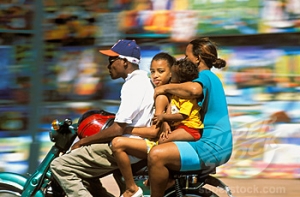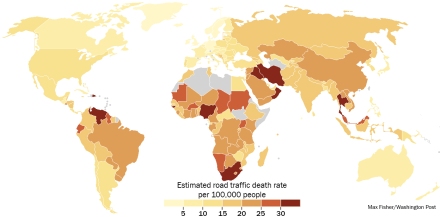In the Dominican Republic last summer, almost every bus, taxi, and car had a decal like this slapped on the windshield:
– God is loyal.
– God takes his time, but he never for forgets.
– With God by my side, who can be against me?
I quickly came to see these as prayers for safety on the roads.
The World Health Organization recently declared Dominican roads the world’s most dangerous. What leads to its high rate of driving-related deaths? To start, the Dominican Republic has abysmal enforcement of speed limits, helmet laws, and drunk driving laws, in addition to poor infrastructure.

Worst of all, though, is what is considered acceptable driving by other drivers, cyclists and pedestrians. Vehicles go through stoplights and stop signs. Streets painted with two lanes of traffic sometimes hold three. At the many unmarked intersections, right of way seems to go to the most aggressive driver.
Though Brazil is much better on the statistics than the Dominican Republic, its driving culture has been hard to adapt to as well.
* * *
Not too long ago in Recife, I took a cab that swerved around to cut off cars, motos, and public buses. At one point, an ambulance with sirens blaring came up behind us, but my taxi driver ended up leaving it in the dust too.
Though this is an extreme example, drivers here seem more aggressive than in the U.S. They’re less inclined to wait their turn, butting in or cutting off or weaving between other vehicles. Let’s be clear – American cities have their fair share of aggressive driving – but here it’s more widespread.
I have to keep my eyes peeled on my walk to and from the university every day. When I’m crossing with a green light, I have to accept that turning vehicles will take the right of way. And just because several lanes of cars are stopped at an intersection doesn’t mean I can cross – a motorcycle might be zipping in between them. It’s sometimes hard for me to keep my cool with all these impatient drivers on the streets.
* * *
I’ve also had some uncomfortable experiences as a passenger in cars here because some Brazilian drivers don’t give enough attention to the road while driving. My housemate, for example, has a car radio with a built-in movie screen, which he has used to watch Madonna videos while he’s in the driver’s seat. I’ve also gotten a ride from a friend who video chatted with his girlfriend en route, and from another friend who had had a couple drinks over the limit.
This brings us to what’s similar between driving in my home and host countries. The U.S. has a higher death rate on the roads than most developed nations, which I’d venture is related to cell phone use and drunk driving.

How do you change the driving culture of a country, be it the U.S. or Brazil, for the better? I believe two factors work together to achieve this.
First, the government has a responsibility to both enforce and educate the public about driving laws. In Brazil, as in the U.S., the government uses billboards and television ads to convince people that it’s in their best interests to drive sober, or wear helmets, or put on seatbelts.
The second factor is even more important. People need to stop accepting bad driving from their friends, relatives, and neighbors. For example, though in the U.S. it’s sometimes tempting for me to have another beer before driving home, I don’t because I’m surrounded by people who wouldn’t allow me to make that poor decision.
So, I’ve decided to not accept bad driving from people who would give me rides. While that’s not going to do much to change the driving culture here in Brazil, it’s my small contribution.
